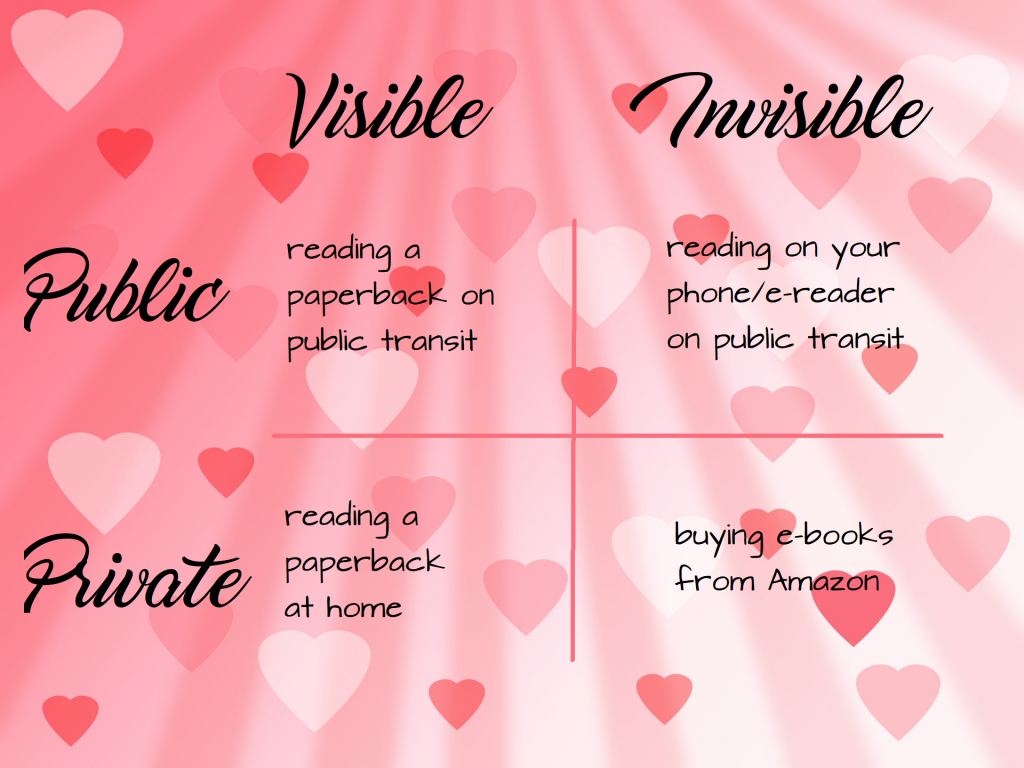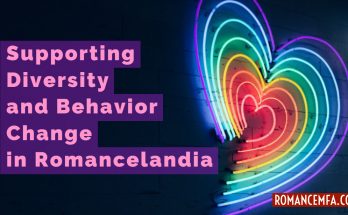Hey Romancelandia—especially white people who are feeling like we can do better—I want to talk about behavior change.
Before I went all in on writing, I was pursing a career in environmental communications. I got a master’s in Marine Affairs, which was essentially public policy, but makes a nice joke now that I’m writing romance. My master’s thesis was on social marketing, aka “using marketing techniques to change behaviors for good” instead of the more usual evil uses of marketing.
The name was coined before social media was a thing, so let me clarify: it’s not about Twitter! It’s about selling behaviors instead of products. I think we’re all seeing behaviors in the publishing industry we want to change these days, which is why I bring it up.
At the time of my research, health pros were all in on social marketing, especially in the United Kingdom. Your gameified Fitbit is an example of social marketing. Smokey the Bear is arguably social marketing, although the campaign predates the coining of the term by Philip Kotler in 1971. Other social marketing you may have seen: trashcans labeled “landfill,” signs in the grocery store parking lot reminding you about your reusable shopping bags, and a great many other things that I’m not going to bother listing here. You have Google if you’re interested in going deeper.
Classification of behaviors
First, behavior can private or public. Second, it can be visible or invisible. I’ll give examples. (Most of my examples are going to be related to environmental behavior, because that’s my background.)
- Private/visible behavior: buying EnergyStar efficient appliances, reading paperbacks at home
- Private/invisible behavior: washing laundry with cold water, buying e-books from Amazon
- Public/invisible behavior: well-inflated tires, reading on your phone/e-reader
- Public/visible behavior: driving a Prius, wearing a band t-shirt, reading a paperback on public transit
Here’s a handy graphic to show the same info, using a pink hearts background as per Ilona Andrews, so you know we’re still discussing Romance.

The reason public-visible is important in behavior change is the concept of social proof. No one wants to be the first to do something, the well-trod path feels safest, humans are sheep, etc. Authors are probably already well familiar with this idea: it’s why getting initial reviews is viewed as critical for a book’s success.
Public visible behaviors have the highest potential for increasing social proof and the highest diffusion rates, which is a fancy way to say
Public visible behaviors are the ones that spread.
Perhaps you’ve heard the phrase conspicuous consumption? I hope so, because it was apparently coined in 1899. Anyway, if you see everyone doing something, then you start to wonder if you should try it too, right? It takes a lot of people, though. If your best friend dumps a bucket of ice water on their head, you say, ‘geez, that was stupid, do you want to borrow a dry shirt?’ but if a million people do it and post a video on Facebook, then suddenly it’s an awareness campaign for ALS and you start to feel like you should dump a bucket of ice water on your head too.
Fortunately not all publicly visible behaviors have to incorporate some form a physical suffering, although it can be uncomfortable to be an early adopter…
But what’s the point of spreading one measly little behavior? The key terms here are gateway actions and cognitive dissonance. You’ve heard that you should stop using plastic bags, or switch your light bulbs to CFLs. Maybe you’ve also heard/thought that these small actions don’t make much difference. So why do environmental organizations keep pushing these actions?
Because the first step is always the hardest. Once you’ve made one behavior change, the next one is easier. You think, “Well, I’m the sort of person who uses CFLs, so I’m also the sort of person who would buy a Priius/vote for politicians who back bag bans/take the bus to work.” You trick yourself into thinking that you’re an environmentalist. You stereotype yourself and begin to act accordingly. New behaviors are often adopted in clusters: you’re working on quitting smoking so you feel that you’re the sort of person who pays attention to what you’re putting in your body and then in addition to kicking the nicotine habit you’re also trying to make more home-cooked meals and drink La Croix instead of coffee in the afternoons. (Unfortunately this works in negative ways too—take a minute to read about the Zimbardo prison experiment for a famous example of people falling into stereotypes and inhabiting randomly assigned roles in the worst way.)
Anyway, if we put all of that together, here’s the progression of behaviors and behavior change that a social marketing intervention will hopefully cause in a population. Say, a population of white readers of romance…
More public/visible behavior => higher social proof => increased behavior adoption within a population => self-stereotyping => adoption of additional behavior in same category

Now that we’re all on the same page about the theory of behavior change, let’s talk action!
I’m not an agent, publisher, or even someone who’s gone to a con so I’ll focus on using reading recs for black authors for positive social change. There have been a kajillion recommendations on social media in recent weeks, but if you’ve somehow missed them, maybe visit Women of Color in Romance, one of the many resources I included in a recent post on What to Read After — or Instead of — Gone With the Wind.
1. Buy the physical books!
Your e-reader is great as an environmental action, but it only gets you a half point for increasing diversity in romance because the book you’re reading on it is invisible. And the invisibility of authors of color is one of the things we’re trying to change!
Go to your bookstore. You know where the romance section is, but don’t walk there by yourself! You want to be visible in your choice. Ask a staff person if they have the book & where it is. Make a stink if it’s shelved in an “African American” section, rather than with an appropriate genre. Read N.K. Jemisin here if you’re not sure why that’s worth making a fuss about.
“But there are so many books I want to buy!” Yes, but maybe you can get the books from well-established white authors from the library? And use your dollars to vote for diversity? Just a thought.
“No, really, I haven’t got the cash.” Get thee to a library. Library books count. Ask a librarian where the book is. Make a stink if it’s shelved in an “African American” section, rather than with an appropriate genre. Alternatively, ask a reader friend to go halvsies on the price. Does your mom/uncle/SIL/bestie read romance? Ask if they’re reading the book and if they’re not, you can say “wow, a lot of people on Twitter/at bookclub are talking about it, it sounds really great. You should check it out (and share it with me).”
“They don’t have it!” You’ve still shown there is demand for the book and that is an important part of taking public action. Encourage the store/library to order the book. Fill out a request form. Sigh heavily & say you’ll get it on Amazon even though you wanted to support local business. Ask if they have reading recommendations from authors of color that are available. Make a stink if they’re all shelved in an “African American” section, rather than by appropriate genres.
Bonus: Once you have a physical book, you have something for the author to sign, and an author to request attendance from at cons or local events.
2. Display the book.
The whole point of this is to be visibly choosing to read this book, so take it on the bus. Pull it out in the waiting room at the doctor’s office. Bury your nose in it during lunch break at work. Escape into another world from your local coffee shop. Strap it to the outside of your carry-on as you head to your gate at the airport and put it over your face while you doze at the beach. I don’t know where you read, the point is that you can choose to do it publicly.
Maybe you’ll have a conversation with someone about the book. Maybe it’ll be a jerk trying to shame you, but maybe it’ll be a new friend who’ll recommend another read. Stigma doesn’t go away if we never act against it.
Bonus: Feeling extroverted? Start the conversation yourself when you see someone looking at the cover of your book.
3. Keep the book visible in the world.
After you’ve read it, don’t forget to rate and review online. Seriously. Remember the social proof thing? Yeah. Query book blogs with your own review. Ask when they’re reviewing this awesome book. Recommend and lend the book to friends. I know we all want to keep our dragon-hoards of literary gold, but consider setting the book free to find its next reader: leave it at the doctor’s office or the locker room at the gym or a Little Free Library in your neighborhood or in a hostel while traveling. Donate it to a high school library and tell them you want to support a diverse book collection for local youth. They’re the future, after all, and they need these books too.
Bonus: You get to do it again! Because there are so many wonderful authors whose skin tone doesn’t match yours but who can tell you a truth about your own heart/entertain you for an afternoon/let you escape everyday life because that’s the magic of storytelling. Yay!
Caveats:
This is still A Very Small Piece of what needs to happen for systemic change. It’s also a very small piece of what a social marketing campaign to increase diversity in the romance publishing industry would involve (I’ve not got any audience research, for starters), and even a very small piece of the theories around behavior change. But I wanted to brainstorm actions that I can take and, knowing that sometimes people freeze up wanting to make changes but not knowing how, I figured it was worth sharing. I hope these ideas will trigger more in your brain. There are many different facets to Romancelandia and whether you are a blogger or a librarian or a fan or a convention organizer or a member of your local RWA chapter or a lurker on social media, take an hour to sit down and have a serious think about what public/visible actions you take as you move through the world. Maybe you can think of some you want to change.
If you have got all the way down to the bottom of this long-ass post and are interested, you can look through the whole dang slide deck from my master’s thesis presentation on Slideshare because the internet is forever and it is still there. Parts of it don’t make sense without narration, like the slide for River of Babies. But feel free to comment here or ping me on Twitter and I’m happy to discuss.



